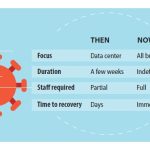May 2020 //
 The COVID-19 pandemic hit businesses like a fast-moving hurricane. In a short period of time, organizations had to completely redefine themselves and set people up to work from home. This has had a profound impact on the way companies run, as the definition of business continuity has been redefined (Exhibit 1). Historically, business continuity plans have revolved around keeping an organization running temporarily with a minimal set of services and people. Today, because of the pandemic, it’s been redefined as running the entire organization, fully staffed, for an indefinite period of time.
The COVID-19 pandemic hit businesses like a fast-moving hurricane. In a short period of time, organizations had to completely redefine themselves and set people up to work from home. This has had a profound impact on the way companies run, as the definition of business continuity has been redefined (Exhibit 1). Historically, business continuity plans have revolved around keeping an organization running temporarily with a minimal set of services and people. Today, because of the pandemic, it’s been redefined as running the entire organization, fully staffed, for an indefinite period of time.
The pandemic-induced work-from-home (WFH) trend is very real and expected to last for quite some time. According to ZK Research, 90% of organizations now have a subset of employees working from home, with many exceeding 95% of the total worker population. Also, 93% of business leaders expect to see a permanent rise in remote working by at least 30% post-COVID-19.